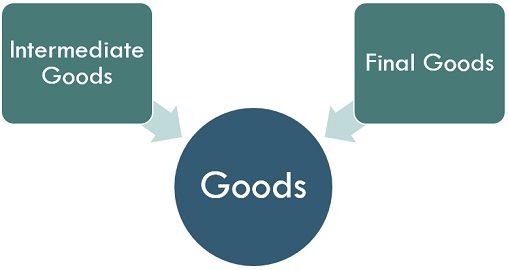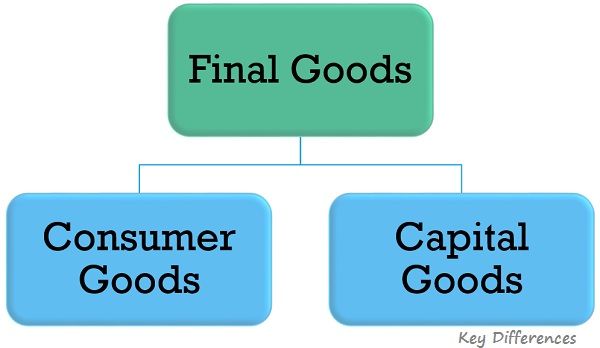 Intermediate goods are goods which are used as a factor of production to produce goods which have the ability to satisfy wants. For this purpose, they undergo the production process. On the contrary, final goods are the goods which are readily available to sale, to the ultimate consumer of the product.
Intermediate goods are goods which are used as a factor of production to produce goods which have the ability to satisfy wants. For this purpose, they undergo the production process. On the contrary, final goods are the goods which are readily available to sale, to the ultimate consumer of the product.
Think of a car, which is a final product, however, the parts used to manufacture a car such as gear lever, tyres, steering wheel, windscreen, windscreen wipers, seat belt, speedometer, bumpers, headlight, taillight, radiators, hoods, mirror and many more, are all intermediate goods.
Come let’s dig a little deeper to understand the difference between intermediate goods and final goods.
Content: Intermediate Goods Vs Final Goods
Comparison Chart
| Basis for Comparison | Intermediate Goods | Final Goods |
|---|---|---|
| Meaning | Intermediate goods are goods which can be used as raw materials for the production of other goods. | Final goods are the goods ready for sale to the ultimate consumer, to satisfy their wants. |
| Nature | Unfinished or Partly-finished goods | Finished goods |
| Usage | It is used by the firms to resell them, to generate profit. | It is used for final consumption or capital formation. |
| Further Processing | Further processing is performed. | Further processing is not performed. |
| Inclusion of value in national income | No | Yes |
| Demand | Derived demand | Direct demand |
| Interdependence | Intermediate goods are used as raw materials, so as to create final goods. | Final goods are produced by using intermediate goods. |
Definition of Intermediate Goods
Intermediate goods as the name suggests are goods which are either reprocessed or resold by the firm.
We all know the fact that – Of all the production undertaking during a particular accounting year in a country, there is only a particular portion of products which results in final consumption. So, the remaining portion is neither final goods nor capital goods.
These are used by the manufacturers in the form of material inputs, in order to produce other commodities, called Intermediate goods. So, these goods are either a part of the final product produced, or their identity is lost during the conversion process.
Intermediate goods are non-durable in nature. The producer supplies such goods to the industries for the purpose of resale, after some value addition.
These are unprocessed or semi-processed products which are used as inputs in the process, so as to be converted into another form. Hence, in the process of production, intermediate goods play a crucial role.
Definition of Final Goods
A final good is a product which is ready for consumption, to satisfy the consumer’s wants or used as an investment by the producers.
In layman terms, final goods are the goods available for purchase by the user, having no intention to physically transform the goods or taking them as a resource to use in the production process. So, they are produced to sell them to the ultimate consumer, using various channels of distribution.
In the calculation of Gross Domestic Products, the market value of newly-produced final goods during the year has to be measured.
Final Goods are further classified into two categories – Consumer Goods and Capital Goods:
- Consumption Goods: Consumption Goods covers goods such as food and clothing, as well as services, which are purchased with the purpose of consumption. It is also called as consumer goods which can be durable or non-durable in nature.
- Capital Goods: Tools, equipment and machines, which are of durable nature and facilitate the production process, but do not get transformed. These goods are called as capital goods, which depreciate over time. These goods are purchased by industries and business enterprises, to enable production and maintain capital stock.
Key Differences Between Intermediate and Final Goods
The difference between intermediate and final goods are explained in the points given below:
- Intermediate goods imply the raw material supplied by one firm to another so that the inputs can be entirely used in the production of other commodities. On the contrary, final goods refer to any product produced for the direct use by the ultimate consumer, so as to satisfy their current wants and needs.
- Intermediate goods can be unfinished goods, i.e. raw materials or partly-finished goods, i.e. work in progress. As against final goods are the finished goods, whose manufacturing is complete.
- Intermediate Goods are resold by the firm to generate income or reprocessed to create final goods. On the contrary, final goods are the goods used for personal consumption by the end-user or new addition made to the capital stock, which is calculated by capital formation, i.e. a net investment.
- Intermediate goods undergo further manufacturing or reprocessing so as to make them ready for sale. In contrast, final goods are complete in terms of manufacturing, so they do not undergo further processing.
- The value of intermediate goods are not included while calculating the GDP of the country, as they are already included in the value of final goods. And if we add it further, then it will inflate the GDP, due to double counting.
- Intermediate goods have derived demand, as the demand for these goods depends on the demand for final goods. As against, final goods have direct demand because these goods are produced with the aim of satisfying the wants and needs of the consumers.
- Intermediate goods act as material input for the production of final goods. Conversely, final goods require intermediate goods, to complete production.
Examples
| Intermediate Goods | Final Goods |
|---|---|
| Sewing Machine purchased by a seller. | Sewing Machine purchased by Tailor |
| Furniture purchased by a dealer. | Furniture purchased by school |
| Electricity consumption at factory | Electricity consumption by a household |
| Computers purchased by a dealer | Computers purchased by cyber café |
| Diesel purchased by a farmer. | Wheat purchased by consumers |
Conclusion
So, with the above discussion, it is clear that whether an item/product is intermediate good or final good relies on its use.
Moreover, there are certain goods which are both intermediate goods and final goods such as salt and sugar, which can be used as an ingredient to produce another product, and also used by households directly their own consumption.






Leave a Reply